In this competitive environment, creating an app isn’t just about technology, design, or strategies; rather, it's about creating emotions that engage targeted users and help foster the app’s growth.
When it comes to “how to develop a handyman app?”, it's not an exception.
Today, Handyman Apps aren't just for booking services; they're also crucial for introducing customers to skilled professionals, simplifying processes, and guaranteeing convenience at every turn.
Are you the one who wants to create a handyman app?
This handyman app development guide can be particularly helpful for all entrepreneurs.
Here, we will cover it all, from the concept, reasons, steps, costs, and monetization strategies.
Let’s begin together.
Understanding Handyman Apps
At their core, Handyman apps are digital platforms where customers connect with service providers to request and plan different household services.
Creating a mobile app helps to engage places where users can easily find and hire reliable workers for jobs such as fixes, maintenance, or installs.
Handyman apps today range in their features from platforms focused on task management and organizing to apps that provide tools for direct contact between customers and service providers.
The worth of these apps rests in their ability to give a customizable, quick, and customer-driven experience.
Every on-demand handyman app shares key features that make the process seamless, from service browsing and booking to payment handling and review systems, ensuring both customers and providers have a smooth experience.
Now, let’s consider the current market stats related to handyman apps in the section below.
Handyman App Stats to Know
With the help of the latest handyman market statistics, you can evaluate the latest data that shows the growth and spread of handyman apps. These numbers showcase the amazing potential for businesses and startups looking to join this booming market:
-
- Market Size & Growth: The global handyman service market is projected to reach approximately $448.89 million in 2024, with an expected CAGR of 16.5% from 2024 to 2033.
- Regional Insights: In 2023, North America led the on-demand handyman app market with 35% of total revenue, followed by Europe at 30%, and Asia Pacific at 20%. Notably, the Asia Pacific region is the fastest-growing, with a projected CAGR of 18% during the forecast period.
- The global handyman software market was valued at $425 million in 2023 and is projected to reach $1.2 billion by 2033, with a CAGR of 10.9% from 2024 to 2033.
- Approximately 1.49 million people are employed in the U.S. handyman services industry as of 2024.
These stats provide a clear picture of the current market trend, showing where possibilities lie for building a handyman app.
Should You Develop a Handyman App in 2025?
Developing a handyman app in 2025 presents an incredible opportunity to break into a booming market with massive potential.
With the rising demand for on-demand app development services, these apps have become the ultimate solution for customers seeking convenient and dependable home services.

Here’s why 2025 is the perfect time to launch your handyman app.
► Explosive Market Demand
More landlords and renters are turning to apps to find workers for jobs like plumbing, electrical work, home fixes, and more.
The current market of handyman apps is expected to increase to USD 530.5 million by the year 2035. Additionally, it is projected to grow at around USD 2340.4 million, which reflects a compound growth of 16%.
► High ROI and Monetization Strategy
There are many monetization strategies adopted by handyman apps to earn money, such as commission fees, subscription models, and advertising.
You can consider the example of Urban Company, which has earned approximately $98 million for the fiscal year ending March 2024. Thus, this growing revenue represents a great scope for your app to have a good income source by developing an app.
► Convenience and Customer Satisfaction
In today’s fast-paced world, customers value ease above all else.
By creating a Handyman app, you provide users with an easy, reliable, and efficient way to access the services they need, boosting customer happiness and driving retention.
Are you ready to create a handyman app?
If yes, then considering the diversified types will help you in selecting the one to proceed with.
Types of Handyman Apps
When trying to develop a handyman app, knowing the different types of platforms offered in the market is key.
Each type serves a unique purpose and responds to specific user needs, ensuring a wide range of involvement for customers and service providers alike.

1. Task Scheduling and Booking Apps
These types of handyman apps focus on easing the process of booking meetings for handyman services.
Examples: TaskRabbit, Handy
2. Maintenance and Repair of Apps
Handyman apps of this type specialize in specific types of services, such as home fixes, plumbing, electrical work, or device care.
Examples: Mr. Handyman, HomeAdvisor
3. Service Discovery Apps
These platforms help users find nearby service providers based on reviews, scores, and suggestions.
Examples: Thumbtack, Angi
4. On-Demand Handyman Apps
Experience lightning-fast assistance for urgent fixes and chores with these dedicated apps.
Examples: TaskRabbit (for on-demand chores), UrbanClap (Urban Company)
5. Marketplace Apps for Handyman Services
These on-demand platforms combine e-commerce with repairs, letting users hire tradies or buy home improvement tools.
Examples: Porch, Home Depot’s Pro Referral
These are the types that you can go through; other than these, you can consider the types such as home improvement Apps, professional handyman networks, DIY handyman apps, and emergency services apps.
Each type of handyman app serves a specific purpose, giving solutions that are tailored to customers' wants.
Now, let’s evaluate the given section for learning the process of how a handyman app works.
How Do Handyman Apps Work?
Handyman apps simplify the process of booking handyman services, giving a smooth experience for users and service providers.
To understand how handyman apps work, consider the following key steps:
-
- The foremost step is related to downloading the app, making an account, and selecting the service, such as electrical work.
- Next, the users can enter information like location, time, and specific needs.
- Now, service providers build accounts showing their skills, experience, and prices to draw users.
- This is the last step, where the handyman accepts or rejects requests, and payments, reviews, and rates are handled within the app, ensuring trust and openness.
Now, let’s learn about the key features that you can include in the following section.
These features can help you include effective insights as defined below.
Key Features Of Handyman App
The development of the handyman app might seem simple at first glance, but there’s a complex backend that allows smooth service delivery, real-time interaction, and a customized user experience.
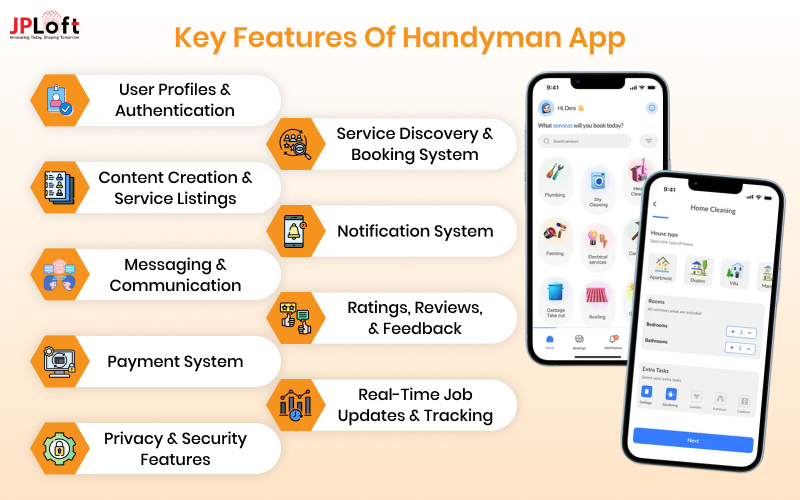
Let’s cover the list of handyman app features below.
1] User Profiles and Authentication
Every handyman app process begins with user registration, encompassing profile building and secure login, where user profiles store essential information like contact details, preferences, and service records to ensure a unique experience for each individual.
2] Service Discovery and Booking System
Handyman apps use smart algorithms to let users find, browse, and book services based on behavior, preferences, and location—all in one seamless platform.
3] Content Creation and Service Listings
Handyman apps enable service providers to create detailed service ads with prices, pictures, and availability, often focusing on community-based solutions to connect users with local, specialized professionals.
4] Notification System
Handyman apps use customizable, real-time notifications to keep users and service providers informed about new actions like service plans, job changes, and feedback requests.
5] Messaging and Communication
Handyman apps include built-in chat for direct customer-provider communication, crucial for discussing job details and resolving issues quickly, thereby increasing user satisfaction.
6] Ratings, Reviews, and Feedback
Core features like ratings, reviews, and comments allow customers to rate service quality and connect with professionals, building trust and improving the overall experience.
7] Payment System
A safe and secure in-app payment method allows customers to pay directly, streamlining the process and providing peace of mind for both users and service providers.
8] Real-Time Job Updates and Tracking
Handyman apps include live tracking for users to see the service provider's progress or estimated arrival time, enhancing transparency and building trust.
9] Privacy and Security Features
Handyman apps offer strong security features like protected conversations, adjustable privacy settings, and safe payment methods to protect user data and ensure a secure environment.
If you’re planning to make a handyman app, it’s important to consider how these components will be combined to meet user standards and offer a smooth, safe experience.
Now, in the following section, you will find the list of top apps that are already leading the industry.
Best Handyman Apps and Their Standout Features
When trying to create a Handyman app, looking at popular apps can offer useful insights into the features and abilities that make them stand out.
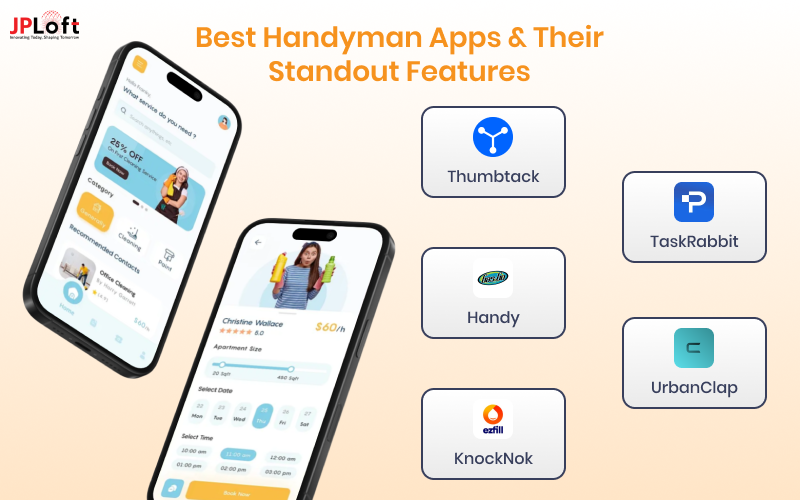
Let’s consider the list of top handyman apps below.
1. Thumbtack
Thumbtack is one of the most famous handyman apps, connecting users with local workers for handyman services. Over time, it has grown into a go-to tool for finding a range of service providers.
Features:
-
- Personalized Search
- Fast Quotes
- Reviews and Ratings
- Payment System
You can estimate the cost to create an app like Thumbtack by evaluating the top factors impacting the same.
2. TaskRabbit
TaskRabbit is another standout app, mainly known for connecting users with workers for various jobs, including home fixes.
Features:
-
- Task Posting
- Live Tracking
- Ratings and Reviews
- Easy Booking
The cost to build a handyman app like TaskRabbit depends on factors such as maintenance, app security, integrating third-party services, and selecting the appropriate tech stack.
3. Handy
Handy focuses on home cleaning and fixes, offering a simple approach to booking workers for household tasks.
Features:
-
- Easy Booking
- Real-Time Notifications
- Background Checks
- Integrated Payments
You can evaluate the complete cost to create an app like Handy after going through diversified factors such as design, features, complexity, and location of the developers.
4. UrbanClap (Urban Company)
UrbanClap, now Urban Company, is a service provider app with a strong focus on handyman services.
Features:
-
- Service Catalog
- Real-Time Tracking
- Instant Booking and Payment
- Background Checks and Ratings
To create an app like Urban Company, you should check the popular strategies that begin with market search and end with app deployment.
5. KnockNok - Local Handyman Help
KnockNok is a trusted site connecting users with skilled local handymen for quick and reliable home services.
Features:
-
- Instant Service Matching
- Custom Quotes
- Verified Professionals
- In-App Scheduling
These were some of the crucial apps that you can consider while building your dream customized app.
After considering the features, concept, working process, and top leading competitors, you are now ready to switch to the next section detailing “ how to build a handyman app?”
Steps to Create a Handyman App
The answer to “how to develop a handyman app?” lies in the top strategies as listed below.

From ideas to launch, we have covered the complete development journey.
Step 1: Define the Concept and Audience
You should identify the app’s purpose after clarifying what makes your handyman app unique. Under this step, you can go through what’s exactly happening in this diversified market.
Here’s what you can check:
-
- Identify the App’s Purpose
- Conduct market research
- Define the Target Audience
Step 2: Choose Key Features and Functionalities
Here, you should select the key features and functions that will best suit to serve the project's aim. Under these features, you can include user names, service groups, booking methods, ratings, and much more.
Two types of features that you can consider are:
-
- Prioritizing Core Features
- Select Advanced Features
Step 3: Create Wireframes and Design the User Interface (UI)
You should develop wireframes through sketching the basics from layout to structure. Under this step, all you need is to conduct a handyman app design that should be simple and engaging.
Consider UI/UX app design via:
-
- Wireframing
- UI/UX Designing
- Prototype Development
Step 4: Choose the Right Technology Stack
It's important to consider the handyman app tech stack after considering the top insights and current technologies in the market.
You can consider the following points:
-
- Frontend Development
- Backend Development
- Database Selection
- APIs and Integration
Step 5: Develop an MVP (Minimum Viable Product)
For creating an MVP, you should consider the essential features that will be helpful in engaging the early adopters.
Follow these points:
-
- Create Essential Features
- Launch the MVP Version
- Gather User Feedback
- Iterate and Improve
Step 6: App Development
This is the step where the core features and functionalities that you have decided on come to life. Frontend is your app’s user-friendly face, whereas the backend handles important tasks like data processing, user identification, and app security.
Here are two areas that you need to cover:
-
- Frontend
- Backend
Step 7: Testing Options
You should consider mobile app testing options for ensuring the quality, functionality, and user experience of applications on diverse devices. Here, you can use different types of testing, tools, and approaches for identifying and fixing issues before app launch.
You can consider the following points:
-
- Performance testing
- Usability Testing
- Compatibility Testing
- Functional Testing
- Security Testing
Step 8: Ensure Privacy and Data Security Compliance
You should ensure the data encryption plans for protecting the user data, especially the personal information such as payment details and personal addresses. Additionally, the mobile app security compliance is one of the determinants that can help sustain the app legally.
You can follow the given points:
-
- Data Encryption
- Compliance with Regulations
- Implement key security features
Step 9: Deploy and Launch the App
Now, it's time to deploy and launch the app in this competitive environment. It will help you ensure that the app functions as intended, performs efficiently, and is easy to use as per the user’s preferences.
The following points can be helpful:
-
- Selecting hosting services
- App Store Submission
- Launch a marketing campaign
You can hire Android app developers or iOS app developers according to your preferences and demands.
Step 10: Collect Post-Launch Feedback and Plan Updates
Collecting the post-launch feedback and plan updates can help focus on a multi-faceted approach. Here, you should implement in-app feedback tools, conduct surveys, and analyze user behavior via analytics.
-
- Gather user feedback
- Monitor user engagement and performance
- Plan regular updates
Following these steps will allow you to successfully develop and launch a Handyman app that effectively serves clients and service providers.
Now, as you learned about the process to make a handyman app, let’s proceed with the resources in the following section.
Cost to Build a Handyman App
The cost to build a Handyman app ranges from $25,000 to $100,000, depending on factors such as the features you choose, the technology stack, the app's complexity, and the location of the development team.
On average, the price can change greatly based on the app's type and scale. Here’s a table to consider.
|
Development Stage |
Estimated Cost |
|
UI/UX Design |
$3,000 – $8,000 |
|
Frontend & Backend Dev |
$10,000 – $40,000 |
|
API Integration |
$5,000 – $15,000 |
|
Testing & QA |
$3,000 – $7,000 |
|
Project Management |
$2,000 – $5,000 |
|
Total Estimated Cost |
$25,000 – $100,000 |
How Long Does it Take to Create a Handyman App?
After considering the cost, the timeline is another factor that can impact the overall development procedure.
Let’s figure it all out below.
|
Phase |
Estimated Timeline |
|
Planning & Research |
1 – 2 weeks |
|
UI/UX Design |
2 – 3 weeks |
|
App Development |
6 – 12 weeks |
|
API Integration |
2 – 3 weeks |
|
Testing & Deployment |
2 – 3 weeks |
|
Total Duration |
3 – 5 months |
Thus, approximately, it can take 3-5 months to develop a handyman app. This timeline can be impacted by factors such as the complexity of the features, the expertise of the developers, and the location of the developers.
Well, when you practically approach the process of building a handyman app, you might come across potential challenges.
Let’s check them out in the following section.
Handyman App Development Challenges & Their Solutions
Building a Handyman app comes with unique challenges.
From ensuring smooth communication between users and service providers to maintaining service quality.
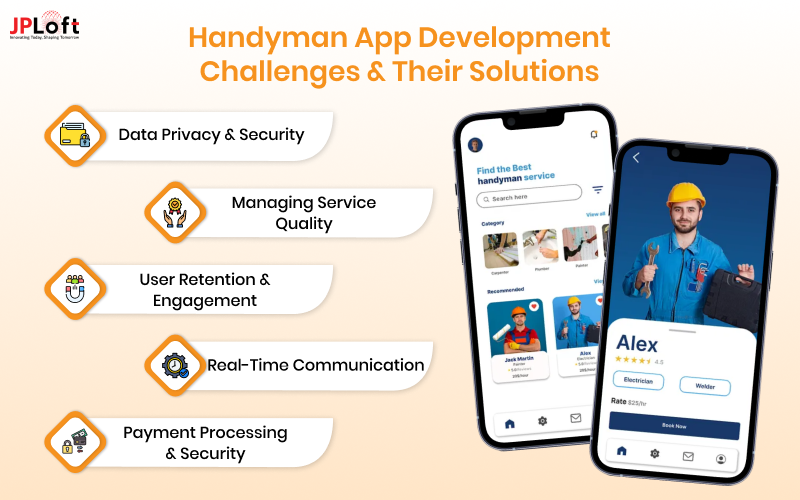
Here is a list of major challenges while creating a handyman app.
► Data Privacy and Security
Challenge: Handyman apps store sensitive user data like contact info, job requests, and payments, raising privacy and legal compliance concerns.
Solutions:
-
- Encryption: Secure data during transfers.
- 2FA: Add extra account protection.
- Legal Compliance: Follow GDPR/CCPA and run regular audits.
► Managing Service Quality
Challenge: Inconsistent service quality can harm the app’s reputation and reduce user trust.
Solutions:
-
- Ratings & Reviews: Let users rate providers for transparency.
- Screening Process: Verify the skills and background of providers.
- In-App Chat: Enable communication to set clear expectations.
► User Retention and Engagement
Challenge: High competition makes it hard to retain users and boost engagement.
Solutions:
-
- Loyalty Programs: Offer rewards and referral bonuses.
- Push Notifications: Remind users of bookings and new services.
- AI Suggestions: Recommend services based on user behavior
► Real-Time Communication
Challenge: Miscommunication leads to delays and user frustration.
Solutions:
-
- In-App Chat: Enable direct messaging between users and providers.
- Live Tracking: Show real-time location and ETA of service providers.
► Payment Processing and Security
Challenge: Secure, smooth payments are essential across regions and methods.
Solutions:
-
- Trusted Gateways: Use Stripe, PayPal, or Square for safe transactions.
- Multiple Methods: Support cards, wallets, and local options.
- Clear Invoices: Provide transparent billing and receipts.
Well, along with the challenges, you should check out the compliances and regulatory parameters that might create an issue.
Proceed with the given section for the same.
Industry Compliance & Regulations You Should Know About
Building and maintaining a Handyman app comes with its own set of safety and regulatory requirements.
From user privacy to worker safety, here are the key laws you need to be aware of when developing your handyman app. Here’s a table for the same.
|
Regulation |
Short Description |
|
GDPR (EU) |
Requires consent, data control, erasure rights, and impact assessments. |
|
CCPA (California, USA) |
Ensures user rights to data access, opt-out, and non-discrimination. |
|
COPPA (USA, under 13 users) |
Demands parental consent and limits data collection for children. |
|
HIPAA (Health data) |
Secures health info via access control and regular audits. |
|
PCI DSS (Payments) |
Protects payment data through encryption and secure storage. |
|
Employment & Safety Laws |
Covers worker classification, insurance, and on-the-job safety standards. |
|
Copyright/IP Laws |
Prevents unauthorized use of third-party content; requires takedown procedures. |
|
App Store Guidelines |
Requires compliance with data, age, and in-app purchase policies. |
|
Built-in Compliance Strategy |
Suggests integrating regulations early to avoid costly revisions later. |
By following these regulatory guidelines and leveraging skilled mobile app development solutions, you can create a safe, trustworthy, and legally compliant custom Handyman app that effectively serves both customers and service providers.
How to Monetize a Handyman App in 2025?
As the handyman app industry grows, determining the best monetization tactics is critical for maintaining income.
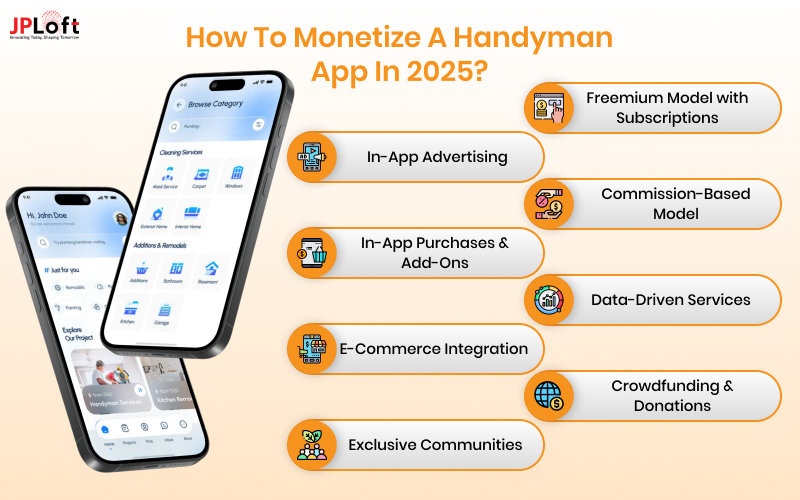
Here is the list of handyman app monetization models to follow.
1. In-App Advertising
-
- Types: Native, banner, and video ads.
- Tip: Use geo-targeted and limited ads to avoid user fatigue.
2. Freemium Model with Subscriptions
-
- Perks: Priority booking, ad-free, exclusive services, discounts.
- Tip: Offer free trials to convert users.
3. In-App Purchases & Add-Ons
-
- Options: Emergency services, profile boosts, and tool rentals.
- Tip: Keep pricing transparent and regularly refresh offerings.
4. Commission-Based Model
-
- Fees: Commission on jobs, booking charges.
- Tip: Balance fees to benefit both users and providers.
5. E-Commerce Integration
-
- Sales: Tools, materials, and DIY kits.
- Tip: Partner with trusted vendors and secure payment gateways.
6. Data-Driven Services
-
- Insights: Customer behavior, performance stats, targeting tools.
- Tip: Stay compliant with privacy laws (GDPR/CCPA).
7. Exclusive Communities
-
- Access: Paid user forums, expert-led workshops.
- Tip: Provide real value through learning and networking.
8. Crowdfunding & Donations
-
- Support: One-time tips or patron programs for providers.
- Tip: Make payments simple and show fund usage clearly.
These monetization strategies can help make your service app profitable while keeping a good user experience.
Why is JPLoft Your Go-To Handyman App Development Company?
JPLoft has expertise in developing Handyman applications that increase speed and customer satisfaction. As a recognized Handyman app development company, we understand the details of user experience, service management, and safe transactions.
Our team tailors each project to meet your unique goals, using agile development techniques and industry best standards. Whether you're starting a new handyman service app or improving a current one, JPLoft offers end-to-end help to bring your idea to life.
Conclusion
Developing a handyman app in 2025 presents a great chance to tap into the growing on-demand services market. By focusing on user-friendly features, easy booking processes, and reliable payment systems, companies can provide a smooth experience for customers and service providers.
Key features like real-time tracking, reviews, and safe transactions will improve user trust and happiness. Embracing new technologies, such as AI, for service tips and unique experiences can further set your app apart. Starting this trip now ensures that your app stays ahead of the competition and thrives in the rapidly changing market.
FAQs
The cost of developing a Handyman app can run from $25,000 to $100,000 or more, affected by the app’s functions, style, and total complexity. Tailoring it to your wants sets the end cost.
Developing a Handyman app usually takes 3 to 6 months, based on its features and difficulty. A thorough plan can help ease the process.
Key features include user profiles, a booking system, payment integration, ratings & reviews, real-time tracking, and push notifications.
Monetization options include commission-based fees, subscriptions, in-app ads, service fees, and the freemium model.
The challenges of developing a Handyman app include ensuring smooth service administration, maintaining a secure payment system, and incorporating real-time monitoring. Addressing these difficulties when expanding the app to meet increased demand may have an impact on the whole development process.
To distinguish your Handyman app, concentrate on providing unique features such as complex scheduling choices, multi-language support, AI-driven service suggestions, and responsive customer care. A visually attractive design and easy-to-use navigation may help the app stand out.
Future developments in Handyman app development include the use of AI and machine learning to improve job allocation, AR/VR for service previews, blockchain for secure payments, and IoT for smart home integration. These factors are influencing how Handyman apps provide value to consumers.
A handyman app connects customers with service providers for home repairs and maintenance. To create a handyman app, you should identify the current market trends, design the app, build an effective tech stack, conduct testing, and then launch as well as maintain it.







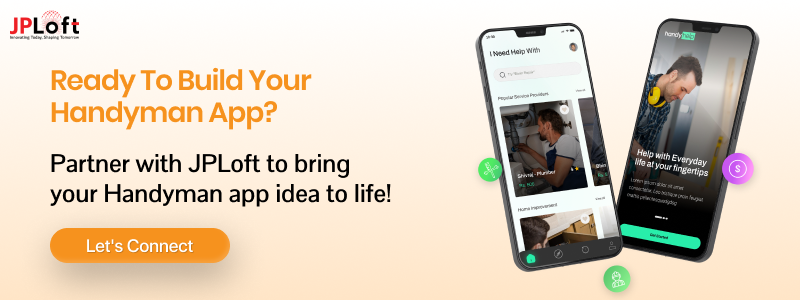

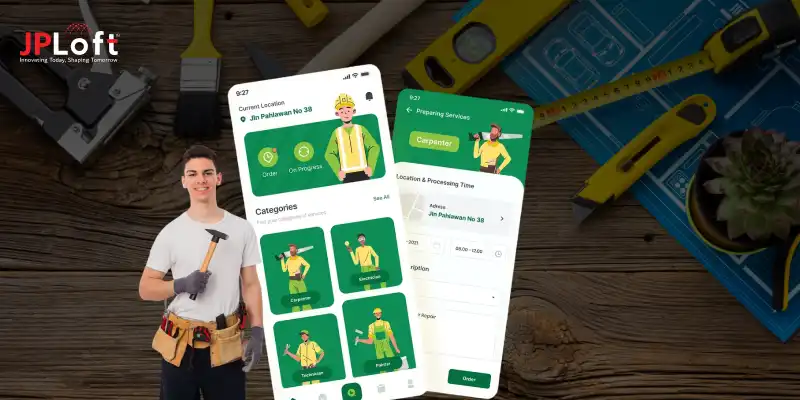




Share this blog